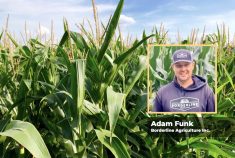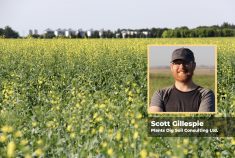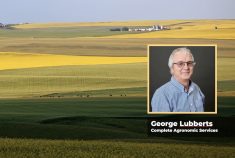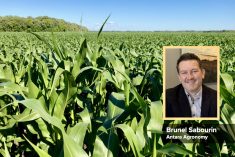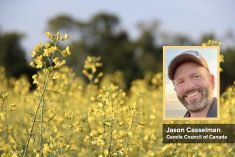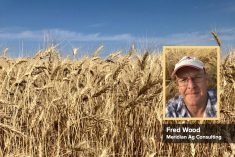It’s one thing to know the benefits of a practice, it’s another to understand the “why,” especially when it comes to biological functions where the road to understanding can be anything but simple.
In cropping terms, science has known about the benefits of longer rotations for years, but not about the exact reasons why.
This may be beginning to change. Over the next 10 years, researchers at the University of Guelph hope to shed more light on how rotations improve soil health and crop performance.
Read Also

Producers aren’t panicking over tariffs and trade threats
The influence of tariff and trade uncertainity on farm business decisions.
For the past 50 years, yield has been the primary measure of success. More bushels means better soil. Within the past five years, however, there has been a growing recognition that if we’re going to keep driving crop yields, we need to look harder and harder at soil health as a partner, not just as some sort of side effect.
It’s with that general view in mind that Dr. Claudia Wagner-Riddle is proceeding with the study at the University of Guelph’s Elora Research Station. The project involves a closed-loop system using 18 large lysimeters installed in the ground to measure properties including water infiltration, gas emissions and soil carbon sequestration, all in a long-term setting.
Wagner-Riddle, a professor in the school of environmental sciences, received original funding of $2 million for the lysimeters and their installation during May and June of 2016. That funding, along with additional money from the Grain Farmers of Ontario, the Ontario Ministry of Agriculture, Food and Rural Affairs (OMAFRA) and the Natural Sciences and Engineering Research Council of Canada (NSERC) will ensure the project runs for three to five years.
“We’ll keep trying to find funding to run it in the long term because using this infrastructure, we’re studying the effect of soil health,” says Wagner-Riddle. “The over-arching goal is to quantify the impact of improved soil health strategies on the soil ecosystem. We’re using this term for a range of good things that we get from soil, such as water filtration, soil carbon sequestration, potentially reduced greenhouse gas emissions and improved soil microbial communities.”
Wagner-Riddle and other researchers will be managing the soil lysimeters in a less-diverse rotation — corn-soybeans-soybeans — which will see considerably lower volumes of biomass returned to the soil during soybean years.
That will be then compared side-by-side with a more diverse rotation of corn, soybeans and winter wheat, with cover crops underseeded in corn after the six-leaf stage and also following winter wheat. Essentially, there will be something growing throughout the year.
The lysimeters were installed with painstaking attention to detail, with nine large soil cores (1.5 cubic metres) taken from sandy-loam soil and nine from a loam soil site. Once in place, a soybean crop was planted, just to get the soil active and test the facility. The 2017 growing season was the first in which the 18 treatments had data collected.
One disadvantage of the lysimeters is that they’ve been installed on a level surface which means they can’t measure run-off. However, the units are so precise, they can collect very accurate data for a water budget, including properties such as evapotranspiration.
“Initially, we’re starting off with similar inorganic fertilizer rates for our two systems, but the idea is that we’ll be adjusting that fertilizer to account for other inputs, including legumes in the cover crops as well as the biomass that gets returned,” Wagner-Riddle says. “The whole theory on these diverse systems is that they require less input and in practice, farmers who’ve used these methods have verified that. It doesn’t make sense to keep the same amount of fertilizer, and we’ll adjust that over the 10 years.”
There is also a production component to evaluate how well the plants are growing and the water content and if those are more favourable for crop growth. Dr. Bill Deen, who’s been involved with long-term rotation plots for more than 17 years, is also contributing to this project. His work has shown that yields are more stable over time with longer rotations and the addition of diverse (i.e. cover crop) systems. He’s also shown that trend-line yields are positive and crops in longer rotations tend to become more resilient to weather extremes such as drought.
“The hypothesis is that the water conservation under those conditions promotes better stability of yields, and we’ll be able to verify if that’s the case,” says Wagner-Riddle. She reiterates that the goal is to go beyond only knowing that it takes place in order to explain why. “If we understand what is happening, we can design other systems and manage them. We have collaborators that are looking at the organic matter components, the microbial communities, water aspects, greenhouse gas aspects, water quantity and quality, and take a ‘big picture’ view of these systems.”
A complex rain gauge
The lysimeters installed at Elora hold a huge volume of soil and weigh it on an ongoing basis. Initially the lysimeters measure evapotranspiration and weigh between 2.8 and 3.5 tonnes. Each unit sits on three loading cells, capable of detecting very small variations (in grams) of mass. Wagner-Riddle states they’re also an expensive rain gauge since they can measure the increase in weight after a rain event, giving them the exact volume of what has infiltrated into the soil. The difference is that most lysimeters are used for water or irrigation scheduling.
“What we’re doing here is bringing together a multi-disciplinary group to study processes more than water — although water is fundamental,” she says. “It’s nice to have the complete water balance, where we can do nutrient balance and measure greenhouse gases in a little chamber that captures those gases as they’re coming out.”
As they’re conducting this research, Wagner-Riddle is hoping to see some of the tradeoffs that growers often experience with systems such as these, where improvements in water quality come with increased greenhouse gas emissions. They can look at these environmental factors along with soil microbial activity, since microbial activity drives so many of these processes.

Dovetailing research
Collaborators from across the country and from different points of North America will provide a wealth of information on improved productivity within cropping systems. That’s why the project draws on work conducted by Dr. Bill Deen, associate professor at the University of Guelph. Deen’s been the lead researcher on the long-term rotation study at Elora, which he inherited in 2000 from Dr. Tony Vyn. Similar work was conducted by Doug Young in the 1990s at the former Ridgetown College of Agricultural Technology, and that work has been continued by Dr. Dave Hooker, now that Ridgetown is a Guelph campus.
It all dovetails nicely with Wagner-Riddle’s work and offers a backdrop on the “knowing versus understanding” outlook that this project entails. Deen’s work has provided clear indication of the benefits of longer rotations, and one of the key messages is the importance of diversity in rotation and cover crops to soil health, drought resilience and a range of other measures.
Ultimately, the clear message out of Deen’s work is “diversity matters” — and this has become a central component linked to what Wagner-Riddle is trying to accomplish.
“We know that a good rotation is more drought-resilient, we know that it has better soil health, regardless of how we define or measure soil health, be it aggregate stability or the Cornell soil health test,” says Deen. “We have evidence that greenhouse gas emissions are lower, and nitrogen-use efficiency is better, but we don’t know why any of that occurs. And that’s where the lysimeters are so valuable, because you can close the loop on the nitrogen cycle, or on moisture balance and it enables us to look at some of these issues and try to understand the mechanisms that we’re observing in the long-term plots.”
There are other big questions too, including how long it takes before some of the properties they’re studying begin to appear.
Asked whether he’s concerned about the length of the study as reflected in the funding, Deen is quick to note that research on rotations and their impact on soil ecosystems, water, air and the overall environment necessarily takes time. Three years is always better than one, and 10-year data is better than five. And he’s confident that funding will continue long term for the lysimeters.
“It’s the same thing as our long-term plots, where in the past there were some challenges for getting the funding in place,” says Deen. “Over time people start recognizing that you need to have these established systems in place in order to get the data you want. We’ll hopefully see the same thing with the lysimeters: once those comparisons get established, the data become interesting.”
Changes in attitudes
At the same time as Wagner-Riddle’s project is getting underway, Deen says he’s noticed an increasing acceptance by growers, who are less likely to dismiss something like wheat in their rotations. He agrees that farmers are recognizing that soil health matters, and in general, they’re starting to see that diversity is very important for soil health.
He’s also noticed that many of the effects he’s been studying are overlapping with other work. Rotations, for instance, may affect water quality, which then leads to land use issues. A decade ago, Deen notes, those links were a little more tenuous, yet today, the discussion has changed and it’s become more informed, primarily because it’s being driven by farmers.
Wagner-Riddle echoes Deen’s statement about farmers wanting more information about long-term cropping impacts on soil health. She believes producers and the agricultural sector in general will benefit from this research, especially being able to quantify those benefits, and determine whether they take on measures that promote soil health, which also become long-term benefits for society. Farmers will eventually get better yields or reduce their inputs but it’s a long-term process, and initially, it might cost farmers more in buying seed to plant cover crops, for instance.
“There is a larger benefit that comes for the environment, and we’re going to quantify that,” says Wagner-Riddle, adding that there is also a component of education and outreach. “Having those numbers is really important for any assessment in terms of economics or the value of those ecosystem services. And that’s the next level for society, where if we improve the environment and water quality, everyone benefits from that.”
Wagner-Riddle wants to acknowledge the many participants involved in the project, although she says there are too many to list. There are graduate students and professors working at the site, alongside collaborators from other universities.
“We’re really excited about this and there are a lot of new learning curves for us and eventually, we will have the data available for others to use,” she says. “Ideally, we’d have a number of sites across Ontario or across Canada with different cropping systems, and perhaps as we learn from it. It’d be nice to have more sites established.”
This article was originally published in the February 2018 issue of the Soybean Guide.




